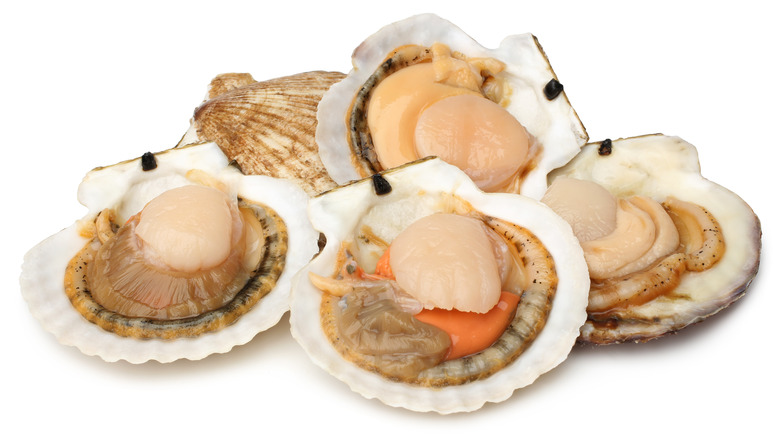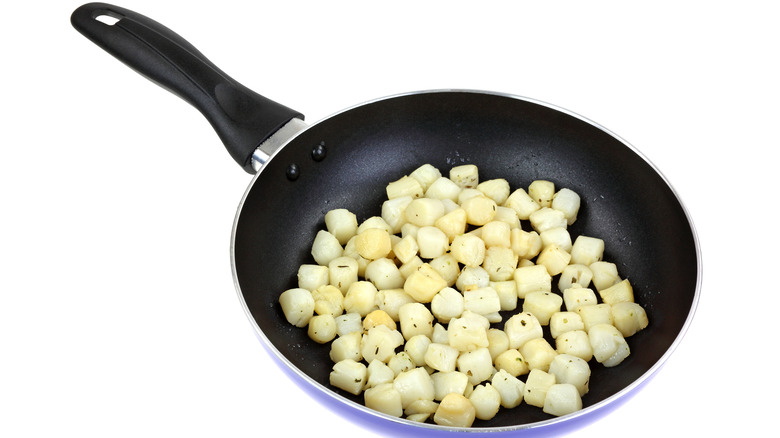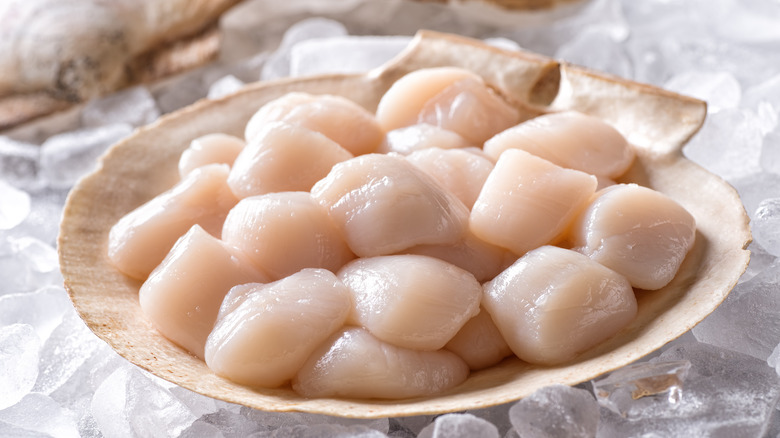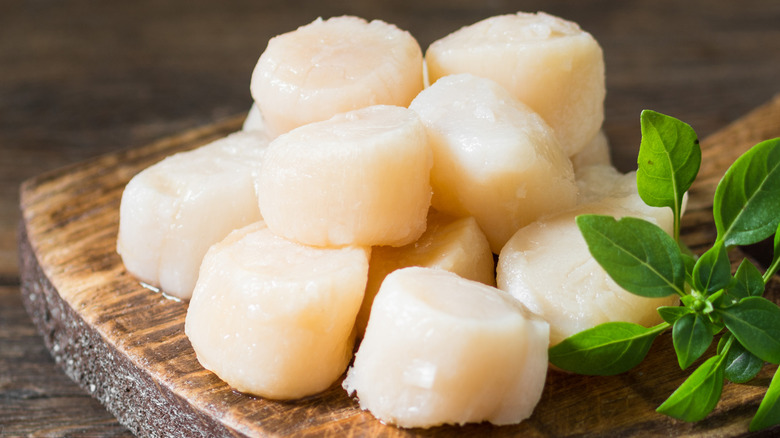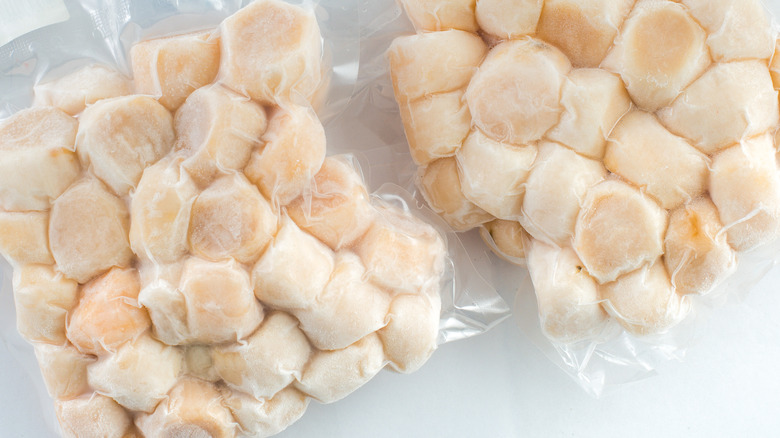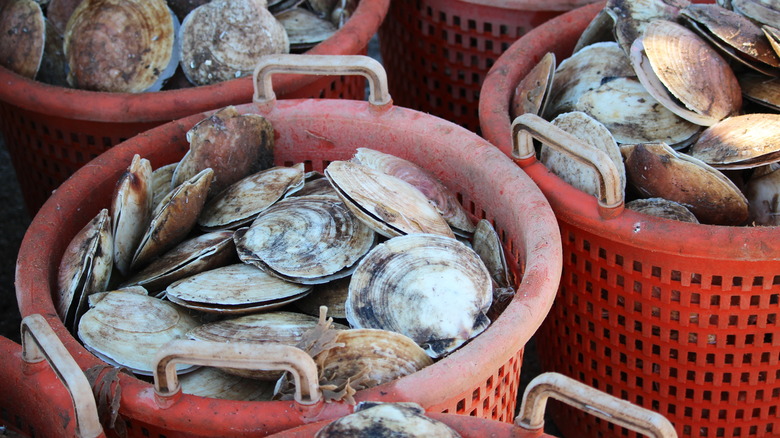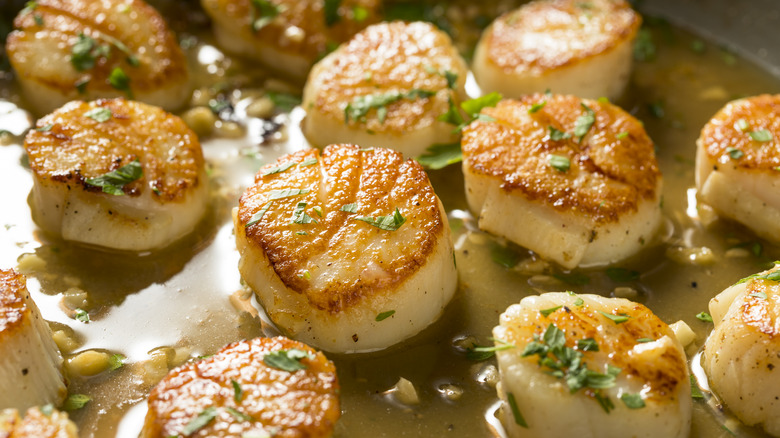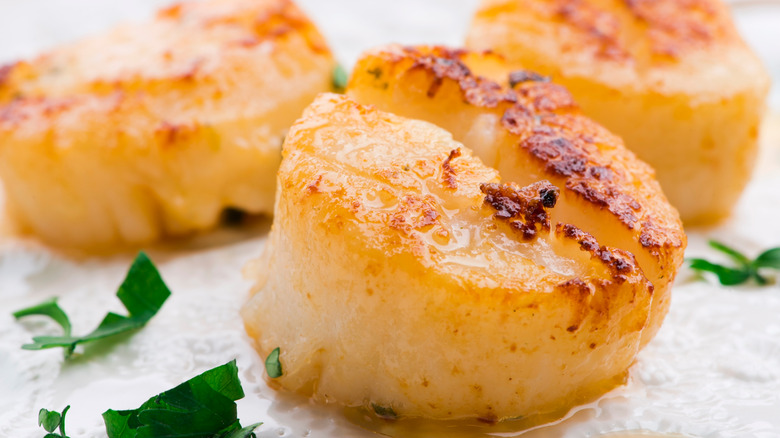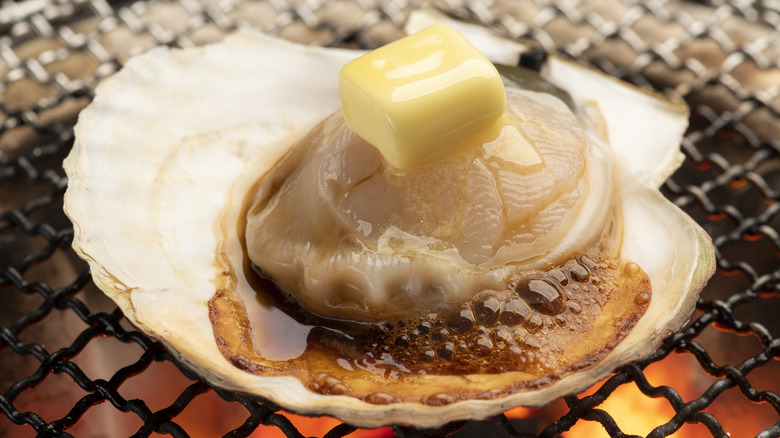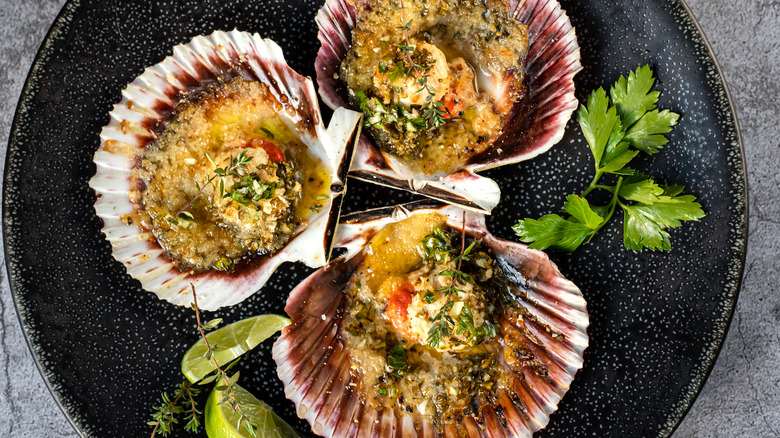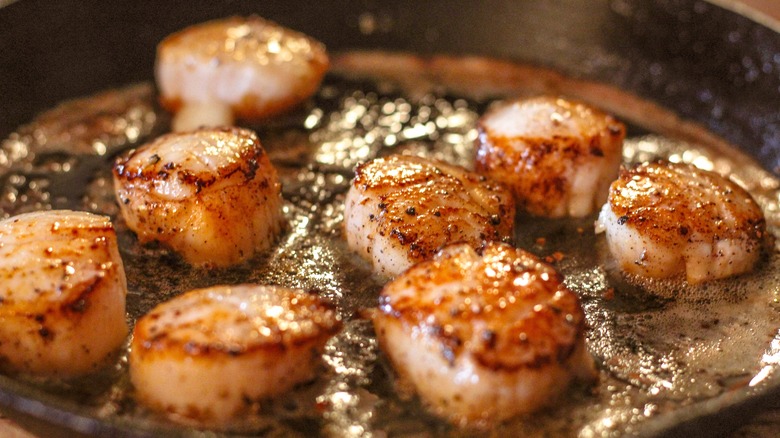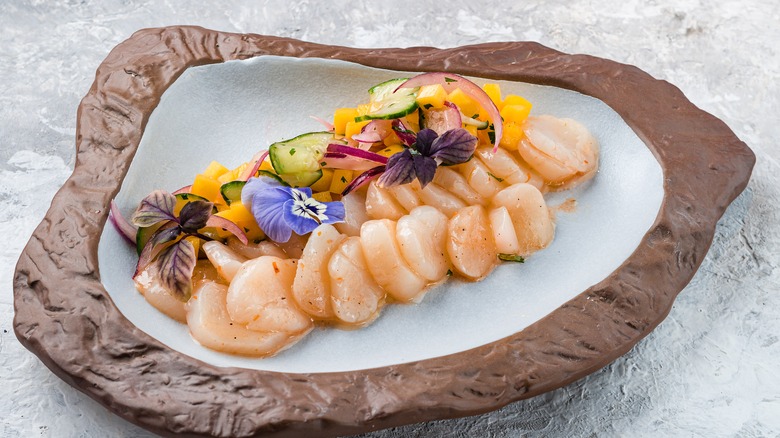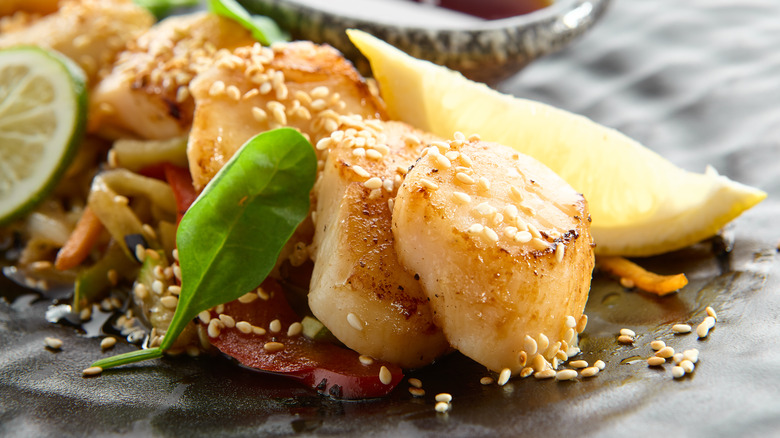14 Tips You Need When Cooking With Scallops
With a subtle taste of the sea, scallops are one of the most popular seafood items. They are sweet and tender and give a feeling of luxury and indulgence. Although they are bivalve mollusks, scallops are so often seen already shucked that people are surprised to learn they grow in shells. Break open the shell and you'll find a whole system of muscles and organs, but it is the adductor muscle (which opens and closes the shell) that we eat.
While not all scallops will break the bank, you probably notice that, in general, scallops are very expensive. A few factors, including size and weight, availability during harvest, and demand dictate prices for this mollusk. For example, scallop prices peak during the holiday season when they are in high demand. In December 2021, prices hit a record high of $37 to $38 per pound, (via National Fisherman). Lower harvest numbers have kept prices high this year, and the trend does not seem to favor prices lowering anytime soon, notes CBS News.
Since scallops are costly, you want to be wise in how you prepare them. The last thing you want to do is spend a bunch of money on food only to ruin it through poor preparation. Scallops are surprisingly painless to cook, but it is also very easy to mess up this protein. That's where we can help. This list of tips for cooking scallops will give you the confidence to cook this shellfish with ease.
Learn the different types of scallops
Understanding the different types of scallops will help you cook them better, and there are over 400 species in existence, (via Britannica). The two main types you will see will be labeled as "sea" or "bay" scallops. Aside from harvest location, the real difference between sea scallops and bay scallops is their size and flavor.
Bay scallops are found in shallow waters along the East Coast. They are very small (as many as 100 could make up a pound), and they are known to be more tender and sweeter. Sea scallops, on the other hand, refer to a separate species, primarily Atlantic sea scallops, which are also found along the East Coast although further offshore. This is the most common type of scallop you will find in the market, and they will work well in most applications. Bay scallops are more often used for stews.
Not all sea scallops are equal, however. If you can, look for "dayboat" scallops. Since dayboats are required to return to shore within 24 hours, these scallops won't spend days out at sea, and they won't be chemically treated. When you see that dayboat label, you can feel confident in the freshness, but you should also expect premium prices for that quality.
You should be buying dry scallops
If you want to buy the best quality scallops, make sure to look for "dry" scallops. Don't get this confused with dried scallops, though. Dry scallops aren't dehydrated. They are "dry-packed" and not chemically treated, whereas "wet" scallops are packed in liquid that contains preservatives. These preservatives include phosphate, which acts as a whitening agent, giving wet scallops an artificially bright white appearance. Dry scallops will have a more natural-looking off-white or pinkish color. That's a big key for detecting if you are about to buy a product that has been packed in preservatives.
Wet scallops may keep longer (and are cheaper), but you will be sacrificing quality. Wet scallops release retained liquid during cooking, essentially steaming instead of browning, and they might leave you with a soapy taste in your mouth. You won't be able to get that beautiful sear that you can with dry scallops. You will be left with rubbery, bland-looking meat that you won't be in a hurry to eat. With dry scallops, you can get a much better sear and achieve an irresistible golden brown crust.
Be on the lookout for fake scallops
You probably didn't think you'd have to be on alert for fraudulent scallops, but this is a concern you may want to have. More expensive seafood items, like scallops, are high targets for selling fake versions. According to Oceana, anywhere from 25% to 70% of seafood on the market may be cheaper fish mislabeled as something pricier. It turns out, this practice is not illegal, (via The Crusty Spoon).
When shopping for seafood, keep an eye out for fake scallops. The Crusty Spoon notes these sham mollusks will likely be made from a paste of shark or skate meat in a similar process to how imitation crab is made. The good news is that fake scallops are not that difficult to identify. Faux scallops will look uniformly cylindrical as if they were stamped out with a cookie cutter, and they are denser than the shellfish they imitate. The Crusty Spoon also advises that with real scallops you will be able to see the muscle fibers running horizontally through the flesh. If you pay close attention, you should be able to make a wise choice at the seafood counter.
Fresh scallops are best but frozen are fine
With seafood, fresh product is generally preferred, but in order to consume scallops in their peak freshness, you'll want to eat them within a couple of days of harvesting. This just isn't realistic for most people, especially those who don't live near the ocean. If you aren't among the lucky few who can harvest their own scallops and eat them the same day, frozen scallops are a great option.
Some people may perceive frozen seafood to be of lesser quality than fresh, but it is a matter of how and when the fish was processed. When scallops are frozen at peak freshness, you can feel confident in the quality. Look for scallops that have been flash-frozen or frozen just after harvesting. Flash freezing (sometimes also called blast freezing or super freezing) is a technological advancement in food processing that allows food to quickly pass through the "ice crystal formation zone," which helps preserve flavor and texture, (via Flash Freeze). If you can find scallops that have been flash-frozen, they may be of higher quality than fresh scallops that have been sitting around for several days. Do take care, however, to properly defrost them. The best way to thaw frozen scallops is to put them in the fridge overnight to slowly defrost.
Buy wild scallops whenever possible
Until recently, you may not have heard much about farmed scallops. That's because wild scallops were plentiful enough to not necessitate large-scale farming. Wild scallops are harvested through dredging, and these are still the majority of scallops consumed. However, the depletion of wild populations has increased the practice of scallop farming.
Farmed scallops tend to be cheaper since their availability is more predictable. They may seem like an attractive option, but the price is not the sole factor in determining value. A major critique of farmed seafood in general is that it has negative health and environmental impacts. Farm-raised fish has shown evidence of being higher in contaminants than their wild counterparts, (via Colorado State University).
That is not to say all farm-raised seafood is worse than wild. According to The New York Times, scallop farming is considered a sustainable practice because it doesn't require any inputs or use of arable land. Bivalves feed themselves by filtering water, which also improves water quality. A handful of small farms in Maine are working to sustainably raise scallops to help relieve pressure on the wild population. If you do plan to buy farmed scallops, try to get some that were sustainably farmed.
Brining scallops makes them more tender
If you follow this one step, you can greatly improve your results with this popular bivalve. Brining scallops will give you the best results, and it doesn't require much effort. This trick is especially important to do when working with wet scallops, although it can still be beneficial for dry scallops.
By brining scallops, you will get more tender and more flavorful meat, and when it comes to wet scallops, it can actually lead to you getting a better sear. Brining will also help neutralize the chemical taste of the preservatives. Another great option is to soak scallops in milk before cooking. Milk will similarly work to tenderize the meat and can even reduce any fishy taste. You can do this by placing your scallops in the fridge in a bowl of milk for about an hour. Whether you decided to do a traditional brine or soak in milk, make sure to dry off the scallops well before you cook them.
Don't use powdered spices on scallops
When seasoning food, it is natural to want to grab your favorite spices to add depth of flavor. You may even have spice blends in your cabinet that you love to sprinkle on everything. You should resist the urge to do this with scallops. One mistake people make when cooking scallops is seasoning them with powdered spices. When you sear scallops, the spices will turn into a paste that not only won't make them look too appealing, it won't even properly season them.
Scallops are best with a simple seasoning of salt and coarse pepper. Salt will help the natural flavor of the scallop come to life, and it will draw out moisture, allowing you to get a better sear. You can use powdered spices on the scallops after they are done cooking, but you can also plan to bring flavor to your dish through different sauces and garnishes. Sometimes less really is more.
A hot pan gets the best sear on scallops
When scallops are cooked properly, they are in a league of their own. Imagine that juicy, tender meat with a lovely brown crust on the top. That crust is a result of the Maillard reaction, a chemical process that occurs when the sugars in meat and vegetables caramelize through heat.
It is heat that is the key to this process. The best way to sear scallops is to have a super hot pan ready. Make sure your pan is sizzling before you add the scallops. Since you need a piping hot pan, it is important to use neutral cooking oil with a high smoke point, such as canola oil. Olive oil and butter have too low of a smoke point, and the milk solids in the butter can burn and leave a bitter taste in your dish. Butter does make a good accompaniment to scallops, but you'll want to add it to a sauce rather than use it as the cooking fat.
Try grilling them for a more complex flavor
You can never go wrong with a well-seared scallop, but it is not the only way to enjoy these bivalves. Consider grilling them as an alternative, especially if you are already a fan of grilled seafood.
There are some benefits to grilling scallops. You can still achieve browning, and they will remain tender given how quickly they cook. The unique characteristic of grilled scallops is the added smoky flavor from the grill. This will be the most prominent with a charcoal grill. You can get a more complex flavor than from searing on the stovetop.
You are going to have the best results with sea scallops rather than bay scallops. The larger size of sea scallops is ideal for grilling. You can put the scallops on skewers so they won't fall into the grill. Simply season them with salt and pepper and brush them with melted butter. They should be cooked through in about five to eight minutes. That's certainly quicker than it would take to grill a steak.
Baking scallops is an underrated technique
We will never ask you to abandon the golden brown scallop, but there is a technique that deserves more love than it gets. Baking scallops can be a delicious and easy way to prepare these mollusks.
This recipe for copycat Legal Seafood baked scallops proves the oven can be just as good of a cooking vessel for these bivalves. Food blogger Molly Madigan Pisula combines the scallops with herbed buttermilk and tops them with melted butter and crushed Ritz crackers. It only takes 20 minutes at 400 F to emerge with a dish of tender scallops. This preparation, made famous by Legal Seafood, will allow the sweetness of the bivalve to shine. Just keep in mind that this dish does not reheat well because of the crisp topping. You want to make this recipe to serve immediately, and, hopefully, the delectable creamy scallops won't leave you with leftovers.
Know when they are done cooking
One of the cardinal sins you can commit against scallops is overcooking them. When you cook all the liquid out of these mollusks, they turn rubbery and overly chewy. You'll want to pay close attention to certain cues to determine when scallops are done cooking.
These seafood morsels will give you clear signs that they are done. The outer surface should have a golden brown crust, and the flesh should be opaque throughout. If they are undercooked, the color would be more of a milky white. You may have noticed how tender, cooked scallops are easily cut with a fork. If they are undercooked, it is tough to cut through them.
This seared scallops recipe could be your go-to scallop preparation. According to Christina Musgrave, it only takes about three minutes per side to get perfectly seared scallops. Scallops can leave people feeling intimidated, but they really are so easy to cook well.
You don't always have to cook scallops
If you are still worried about ruining scallops by cooking them improperly, fear not. You don't even need to cook them. When working with scallops in peak freshness, they can be very enjoyable raw. From crudo and carpaccio to ceviche, there are a number of raw preparations that will bring out the delicate sweetness of this seafood item.
A scallop ceviche recipe is a quick and easy way to serve raw scallops. You will dress the bivalves with cilantro oil and pisco (a South American brandy) and garnish with pomegranate seeds and chili pepper. No wonder this dish is called conchas borrachas, which means drunken scallops. An easy preparation like this may make you think twice about wanting to cook this protein.
When you eat raw scallops, you do want to pay extra attention to quality, as eating raw seafood can put you at risk of foodborne illness. If you source them fresh from a trustworthy vendor, you shouldn't need to worry about getting sick.
Don't use strong sauces and flavors
Scallops have a delicate, mild flavor. Their sweetness and brine are subtle. If you choose very strong flavors for a dish featuring scallops, you may find them to be overpowered by the other elements.
Instead, it is best to choose simple and light flavors to pair with scallops. Understated pairings will get you the best results. Scallops go well with other ingredients that have a delicate flavor, such as peas. They also go well with butter and cream sauces, which is why you'll find so many scallop recipes with a creamy element. You can also not go wrong with a little acid. Lemon wedges take seared scallops to the next level with a touch of brightness.
If you want a little spice in your dish, try a tomato sauce flavored with chiles and serve that over pasta rather than dousing them in hot sauce. Balance is your friend if you want more adventurous flavors with your scallops.
Explore different scallop recipes
With a click of a button, you can find endless scallop recipes. With these tips and tricks, you can cook scallops like a pro, but it will be up to you to turn them into a meal. Don't be afraid of trying some new recipes featuring this popular mollusk.
Bacon-wrapped scallops will always be a crowd-pleaser at a party, but there are so many other opportunities to make the most of this food. Experiment with different pasta dishes. Scallops could elevate a humble dish of shrimp scampi, instantly giving it a feeling of luxury. If you are feeling brave, you could try this recipe for scallop consommé. From chef Daniel Humm, this is an advanced recipe with a huge payoff resulting in delicious scallops. Another enticing option is this scallops with butternut squash purée recipe, which accentuates the meat with delicate yet rich flavors.
